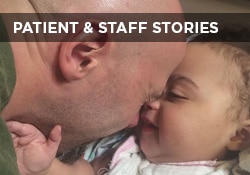This website uses cookies so that we can provide you with the best user experience possible. Cookie information is stored in your browser and performs functions such as recognising you when you return to our website and helping our team to understand which sections of the website you find most interesting and useful.

Susan E. Mazer, Ph.D. Blog
Thoughts and ideas on healthcare
Hi, and welcome to my blog! I'm Susan E. Mazer -- a knowledge expert and thought leader on how the environment of care impacts the patient experience. Topics I write about include safety, satisfaction, hospital noise, nursing, care at the bedside, and much more.
Why Patients Suffer the Nighttime Hours
October 17, 2022
Sleep has never been easy for me. As I child I would beg my mom to “sing me to sleep.” As an adult going through high stress events, I would take music to bed with me to give me something outside of myself to focus on. Today, it is “Alexa play…”
When I am traveling alone, staying in strange hotel rooms on beds shared with an infinite number of strangers that came before me, sleep remains challenging. I sleep, just not much. Strange sounds, people, and unfamiliarity with my surroundings all disturb my sleep. To relieve my own anxiety, sometimes I leave the lights on, which leads to unsettled sleep!
My experience as a hospitalized patient is most memorable from my emergency admission direct from my Southwest Airlines flight returning home from Florida, the Middle East, and Europe. I had been out of the country for six weeks. I flew back to Reno from Orlando. When I was trembling, had chills, and was feeling faint, my husband, Dallas, declared an emergency. EMTs met the plane and took me directly to the closest hospital. I was admitted to the emergency room and where I found out I had E. Coli Septicemia.
I spent five days in the ICU and then five days in a step-down unit. Sleep came in the ICU only because I was so sick and infectious. My sleep was further impaired by the accompanying medications, plus four IVs. However, in my most difficult waking moments, there was one classical sounding music loop (about 15 seconds) on the television that I could tolerate. I could not listen to talk television or anything else.
The fact is that sleep was never restful when I was in the ICU or in the Telemetry unit. For anyone who finds themselves in the hospital overnight, the expectation of a “good night’s sleep” may be illusory. The better I got, the more disturbing my own thoughts were.

Sleep: Why is it so elusive when we need it the most?
I asked the late Dr. John Chappell, psychiatrist and faculty member at the UNR School of Medicine in Reno, why nights were always so difficult for me. His answer, “because so few resources are available to you.”
“Nocturnal Ruminations” occur when our brains are on infinite repeat, thinking about fears, anxieties, regrets, “what-ifs”, and other discomforting events from the past or thoughts of the future, over and over. Our minds play like a juke box with unlimited quarters on an endless loop!
A study published in the Journal of Clinical Sleep Medicine identified ruminating as a significant cause of insomnia in and out of the hospital, as well as medications, noise, and disruptions for other reasons.
Nightingale knew this. She wrote that “Apprehension, anxiety, and expectation,” are damaging to patients.
The absence of the many resources available during the daylight hours that are unavailable at night makes over-thinking much too easy. Social support almost comes to a halt. There are fewer people around and fewer opportunities for positive distractions to mute the mind-chatter that fills a patient’s head at night.
Although ICU insomnia can have many causes, for patients who do ruminate when left alone at night solutions are not always available. White noise, pink noise, and music have each been studied relative to assisting patients in “falling asleep.” However, the challenge of “staying asleep” is not addressed. Patients awaken and then what?
Silence is neither absolute nor completely quiet. In fact, disquiet, uneasiness, is not always caused by external events. Rather, it can be generated from within the intimate privacy of the patient’s mind.
In any case, patients lying awake at night in the hospital, for whatever reason, suffer. And these nights feel endless.
Empathy and compassion ask that we listen to and on behalf of our patients, that we assume they hear everything we hear. Nightingale warned us to be mindful of not creating “expectation, anticipation, and fear of surprise.” The sense of hearing is always in want of understanding.
When considering auditory solutions to improve sleep, it helps to begin with how you want your patient to awaken. Exhausted? Frustrated? Confused? Calm? Peaceful? Relaxed? Refreshed? Once a patient finally sleeps or can rest, their awakening should be one that is comfortable and reassuring.
The use of white or pink audio to mask noise or improve sleep may work for some patients. However, these various kinds of ‘noise’ can lack a cognitive or emotional focus. Offering patients a choice between listening to music or not, can be helpful in opening the discussion.
From the start of Healing Healthcare Systems in 1992, we have provided a stunning midnight starfield for overnight viewing with soft lighting and restful music. More recently through C.A.R.E. Connect, our online app, white noise options are available.
Sleep: Plan for it
The Patient Day is a full 24-hour day. Within this span of time, sleep is accounted for but not planned for beyond lighting and medication. The nursing staff continues to monitor and care for patients at night, however night is so different than day. Many efforts are placed on “quiet at night” protocols without looking at whether they are effective in relieving the worry and angst of the patient who lies in wait.
“Quiet at night” does not necessarily lead to a good night’s rest. And, what is “quiet at night?” Certainly, there is no total silence in any clinic or hospital. The word “quiet” is relative and not merely soundless. Rather, it needs to be serene, calm, still, and peaceful.
I learned about ICU psychosis in 1992 when we began producing The C.A.R.E. Channel. The challenge at that time was that most ICU units were “inside” units without windows. The lack of appropriate clues as to the day and night cycle frequently caused disorientation among acute patients. Therefore, we produced a midnight starfield so that our 24-hour programming would offer a visible and identifiable cues for nighttime.
In addition, for home use by patients who have their own personal devices, we offer white, pink, and brown noise files. C.A.R.E. has soft, relaxing music at night. The white noise offering is to serve those who prefer it and perhaps use it at home.
The ideal, of course, is for patients to sleep with the knowledge that they are not alone, they are safe, and if they awaken we can figuratively hold their hands. C.A.R.E. is especially effective in serving the needs of patients in the middle of the night, not only in the middle of the day. We have produced our midnight starfield for three decades, together with sunsets and sunrises. C.A.R.E. with its specific night programming is currently used in over 1000 hospitals.
Given that sleep patterns are well established at home, it would help to ask patients or their families how they usually sleep, if they normally struggle at night, and if evenings are comforting or not.
Plan for sleep. Work with your patients to learn what is comforting for them. Ask them every morning how they slept. If the answer is ‘not good,’ ask them what might have helped. Better still, offer tools from the onset to make nights comforting instead of frightening.










